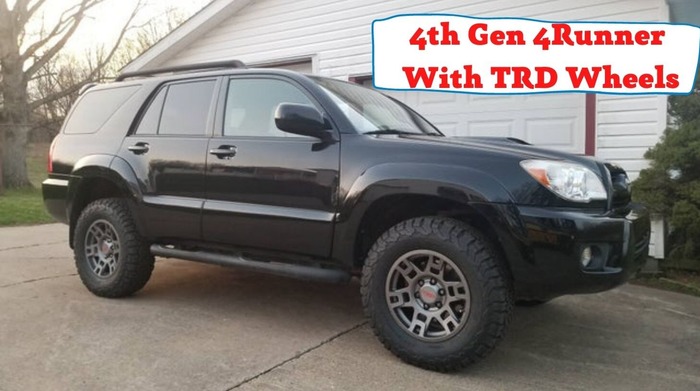
Time after time, 4Runners have maintained the badge for being virtually indestructible. It is practically common to see an authentic and road-worthy twenty-year-old 4Runner cruising down the road. Although Toyota did an excellent job with all the 4Runner editions, it made outstanding improvements on the 4th Gen 4Runner. Toyota redesigned the 4th Gen 4Runner into a classy, yet legendary offroader. The 4th Gen 4Runner is the only 4Runner generation with a V8 engine. The engine provides better power output and acceleration.
If you are lucky to have bagged yourself a 4th Gen 4Runner, consider upgrading its wheels to a set of wheels that offer better off-roading performance, braking, ride comfort, drivability, and aesthetics.
Toyota Racing Development (TRD) wheels
If you plan to give your 4th Gen 4Runner an upgrade, a new set of wheels will be the ideal upgrade for the mid-sized SUV. Nothing stands out like a set of customized wheels on a mid-sized SUV. Wheels affect the vehicle’s performance, noise levels, fuel economy, comfort levels, and the general appearance of the vehicle. A set of themed wheels can make your vehicle look surprisingly special. People often install new wheels in their vehicle to:
- Add personality and character to their car. Wheels come fitted in unique styles, thus making it easier to find unique wheels that perfectly suit your style.
- Others install new wheels due to unavoidable circumstances.
- Some do it as an upgrade for their car to get the ultimate performance.
Go for bigger and better wheels.
Benefits of bigger wheels
As we’ve mentioned earlier, wheels affect a vehicle’s performance. Consider bigger wheels for your car for aesthetic as well as functionality. Bigger wheels offer superior traction performance. Bigger and better wheels will impact your 4th Gen 4Runner in several ways.
- Bigger wheels will provide more stability.
- Installing bigger wheels means adding extra off-road capabilities to your 4th Gen 4Runner. Bigger wheels give a car superior traction performance and good crawl control functionality.
- Bigger wheels provide improved ride comfort. Off-road enthusiasts value comfort offered by their vehicles as they drive through offroad terrains.
- Bigger wheels offer a better suspension system for your 4th Gen 4Runner.
Remember, bigger wheels equate to bigger tires which ultimately equates to spending more money on your wheels. Try to find a balance between practicality and your budget. So, if you are one of the few people who snagged themselves a 4th Gen 4Runner and would wish to make your 4Runner look sportier, then get yourself a set of TRD wheels.
Why should you swap to TRD wheels?
TRD wheels are lighter
Aluminum alloy makes TRD wheels lighter compared to steel wheels. The lightweight reduces unsprung weight on your vehicle. Unsprung weight is weight that is not supported by the car's suspension and spring. Reduced unsprung weight makes it easier for your 4th Gen 4Runner to maneuver especially on rough terrains. It improves the car handling performance which equates to improved ride.
The lighter weight also improves gas mileage and acceleration.
TRD wheels provide a wider stance
Most TRD wheels come with 17" diameter, 7" width, 11 mm backspacing and 4mm positive offset. The size means TRD wheels provide a wider stance. A wider stance translates to a wider wheelbase which equally distributes the vehicle's center of gravity.
In addition to this, a wider stance also translates to better stability, better handling performance, and reduced side slip.
Visually pleasing
A wider stance or bigger wheels give the car an aggressive look. It gives your 4th Gen 4Runner a vintage hot-rod look.
TRD wheels absorb much heat and dissipate it better compared to steel wheels
The aluminum alloy used on TRD wheels allows the wheels to handle heat much better compared to other wheels. It results in better brake performance since the brake system will remain cooler for extended periods.
TRD wheels specs
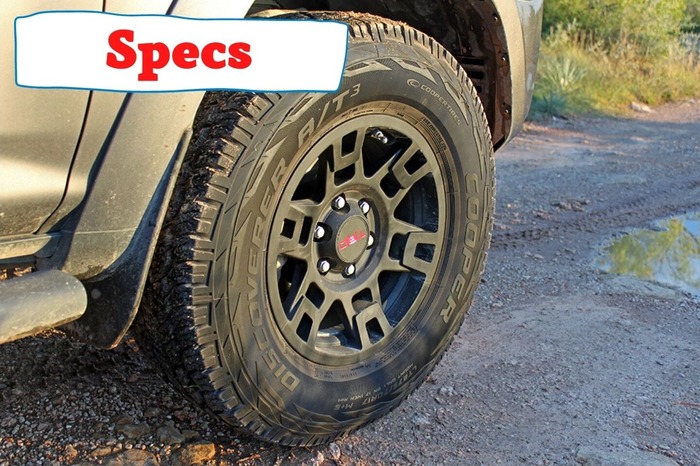
TRD wheels are produced under high heat and pressure to modify the aluminum into the desired shape. Toyota customized TRD wheels to provide great traction among its offroad trucks. It is a favorite and highly sought-after attribute among offroad enthusiasts. TRD wheels come in three distinctive styles: billet, cast, and forged TRD wheels.
Each style has its unique pros and cons.
Billet TRD Wheels
Toyota processes billet TRD wheels from a chunk of aluminum. The grain structure remains intact resulting in a strong wheel.
Pros
- They are extraordinarily strong compared to Cast TRD wheels
- They are slightly lighter compared to cast TRD wheels.
- One can get numerous built from the billet wheels
- You can repair damaged billet wheels
Cons
- It is expensive to produce compared to cast TRD wheels.
- Billet wheels are not readily available in the market. You need to custom-order a set of billet wheels.
Cast TRD wheels
Toyota produces cast TRD wheels by pouring molten aluminum into a mold. It is the easiest to make.
Pros
- Inexpensive
- Readily available
- Amazingly easy to machine
Cons
- The process of casting wheels can lead to porosity hence making cast wheels prone to breakages.
- They are not as strong as the other TRD wheels.
- They easily break compared to other TRD wheels. They break if put under lots of pressure.
- Cast wheels use more materials due to porosity making them slightly heavier.
Forged TRD wheels
Toyota produces forged TRD wheels by using a single piece of billet aluminum to make a forged TRD wheel. The forging process entails heating the aluminum billet under extreme heat and pressure. The process allows the grain in the aluminum to align, thus giving them a more defined structural integrity. It’s no surprise that forged TRD wheels are the most sought-after TRD wheels. They are by far the strongest and most expensive TRD wheels.
Pros
- The forging process results in a wheel with incredible strength. The forging process reduces the likelihood of porosity or shrinkage from occurring.
- They have more consistency compared to a cast wheel
- They are mechanically strong, making them have superior wear resistance.
- The wheels exhibit impeccable load towing capabilities, thus preferred by truck lovers.
- Forged wheels don’t need extra material to make them stronger, thus slightly lighter than cast TRD wheels.
Cons
- Forged wheels are the most expensive option.
- They are not readily available. You need to custom-order forged wheels
Regardless of the type of the wheel, Toyota designed the TRD wheels to provide satisfactory weight management, brake, and offset clearance. Toyota preferred aluminum material because they are generally light, have a high tolerance for heat, and provide the best rigidity.
Apart from the machining process, one can further group TRD wheels into three grades: TRD sport, TRD off-road, and TRD pro. They have distinctive features and different off-roading capabilities.
TRD wheels colors
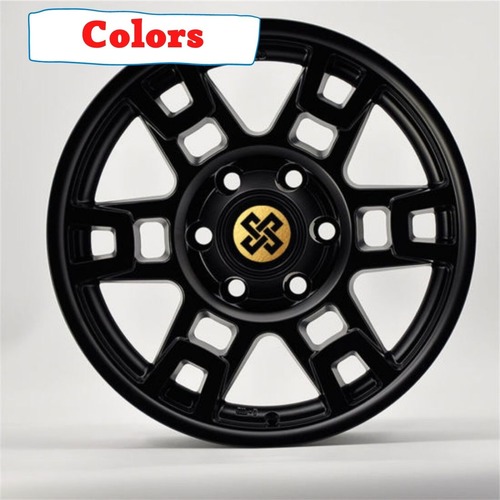
TRD wheels come in two primary colors: matte black and matte gray (gunmetal finishing). Occasionally, you might get them in bronze, gloss black, or graphite.
All in all, the matte black TRD wheels look visually pleasing on a variety of 4Runner colors especially the Magnetic Gray Metallic or silver-colored 4Runners. The wheels blend well with black tires with a red TRD logo at the center. Such a wheel paired with a dark-colored 4th Gen 4Runner gives an aesthetically pleasing contrast of color. Ultimately, the color you choose depends on your personal preference.
You can also paint your TRD wheels to customize them further. You can paint them yourself or let a professional do it.
For custom-order, TRD wheels consider powder coating or painting the wheels to get the desired color shade. If you decide to do it yourself, follow the next steps:
- Clean the wheels. The trick to getting a pro-like painting job is by thoroughly cleaning your wheels. They need to be spotless before you begin painting them.
- Once they are clean, lightly sand to soften them. You can use wet sandpaper to get a softer finishing. Sand the entire wheel and remove any shiny spot on the wheel.
- After sanding the wheels, go over the wheels with a scouring pad to even out any spots you may have missed while sanding them.
- To get a neat paint job, ensure you mask the wheel.
- Paint the wheels. Begin by spray painting the wheel with a paint adhesion promoter. The adhesion promoter acts as a primer. It also enhances paint adhesion.
- Spray the paint in a dust-free environment. Spray several layers of thin coats. The paint particles should flow evenly to get a neat finishing. After the first coat has dried up, run a rag to remove any particles that might have settled as the paint was drying. You need to ensure the wheel surface is smooth before spray painting subsequent layers.
- Lastly, spray the wheels with a clear top coat for extra protection. If you want a glossy look, go for a glossy clear coat. If you prefer a matte finish, go with a matte clear coat.
TRD Wheel size
TRD wheels come in three sizes: 17” diameter 7” width; 17” diameter, 7.5” width; and 16” diameter 7” width. The 17” diameter 7” width looks better on 4Runners compared to the 16” diameter 7” width TRD wheels. TRD off-road wheel's standard size is 17" diameter, 7.5" wide while the TRD Pro is 17" diameter, 7" wide, and lastly, the TRD Pro wheel is 16" or 17" diameter 7” wide.
The difference in width affects gas mileage and acceleration. A narrower wheel makes the wheel lighter, thus increasing wheel protection. On the other hand, Wider wheels lead to better acceleration and better traction.
The width of your wheel may also affect the shape of the tire.
With regards to the width, 4th Gen 4Runners look better on a 17” diameter 7” width wheel.
The TRD wheels are slightly lighter compared to other wheels designed for trucks and SUVs. They are approximately 25 pounds. Light-weight wheels are better at accelerating, braking, and fuel economy compared to heavy-weight wheels.
TRD Wheel offset
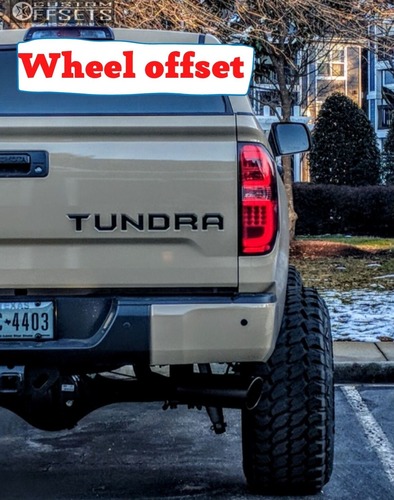
Wheel offset measures the distance from the hub or rather mounting surface to the center of the wheel. A Proper wheel offset gives the wheel enough clearance and stability. A wheel can have zero, negative, or positive wheel offset.
- Zero-wheel offset means the mounting surface is on the same line as the wheel’s centerline.
- Negative wheel offset means the mounting hub is at the back of the wheel and the vehicle’s suspension system. The mounting hub is behind the wheel’s centerline.
- A positive offset means the mounting surface extends right in front of the wheel’s centerline. The mounting surface is close to the wheel, and it faces the road.
TRD wheels come with a +4mm wheel offset. The excess positive offset may cause the following problems.
- Damage to the inner surface or edge of the wheel
- It may interfere with the car’s braking system.
- Increases the likelihood of tire failure.
- It may make your car unstable.
- Causes car handling problems
Offset measurement is as straightforward as it sounds. The wrong offset can significantly reduce your car's stability. Ensure the offset in your new set of TRD wheels does not surpass the 5mm mark especially if you intend to go with wider TRD wheels.
If you decide to go with a negative offset, remember that excess negative offset may cause:
- Unsatisfactory car handling
- Excess stress on the car’s suspension system
- Throwing a lot of unwanted debris on the car
- Excessive steering wheel recoil
Negative offset means the wheels on your 4th Gen 4Runner will push outside the fenders. This will give your car a concave style since the negative offset pushes the tires out.
TRD wheels backspacing
Don’t forget wheel backspacing. Backspacing is a measurement system commonly used to determine the depth of the mounting pad. Backspacing size impacts the car's suspension, steering, and braking system. Wheels with positive offset give the wheels more backspacing. Enough backspacing allows the suspension, braking, and steering system to operate without any form of interference from wheels. A negative offset gives the wheel less backspacing. The standard backspacing on TRD wheels is around 11mm.
TRD wheels’ quality
Toyota and Toyota Racing Development designed and produced TRD wheels. Toyota Racing Development is Toyota’s tuning shop known for upgrading and improving streetcars’ performance.
Toyota Racing Development division employs CAD design to create an ideal wheel to provide impeccable stability and appearance to your 4th Gen 4Runner. Additionally, the aluminum alloy makes TRD wheels lighter compared to steel wheels. When developing the TRD wheels, Toyota took into consideration how the wheel will affect the backspace, offset, weight, and brakes of your car.
TRD and Toyota patented the design of TRD wheels. No aftermarket producers can make the TRD wheel without infringing the patent. Therefore, genuine Toyota TRD wheels are of excellent quality.
You get outstanding off-roading capabilities and a commitment to quality when you invest in TRD wheels.
Concluding thoughts on TRD wheels on 4th Gen 4Runner
If you are looking to make your 4th Gen 4Runner perform and look even better, we would recommend a swap to TRD wheels. They offer more stability, better gas mileage, and acceleration. TRD wheels also look great on a 4th Gen 4runner. Moreover, you can easily install TRD wheels at home or simply let a professional take the stress off your hands.
Remember, there are many knock-off TRD wheels in the market. If you cannot get a set from Toyota, ensure you purchase your wheels from reputable Toyota parts dealers.
About the authors
The CarAraC research team is composed of seasoned auto mechanics and automotive industry professionals, including individuals with advanced degrees and certifications in their field. Our team members boast prestigious credentials, reflecting their extensive knowledge and skills. These qualifications include: IMI: Institute of the Motor Industry, ASE-Certified Master Automobile Technicians; Coventry University, Graduate of MA in Automotive Journalism; Politecnico di Torino, Italy, MS Automotive Engineering; Ss. Cyril and Methodius University in Skopje, Mechanical University in Skopje; TOC Automotive College; DHA Suffa University, Department of Mechanical Engineering

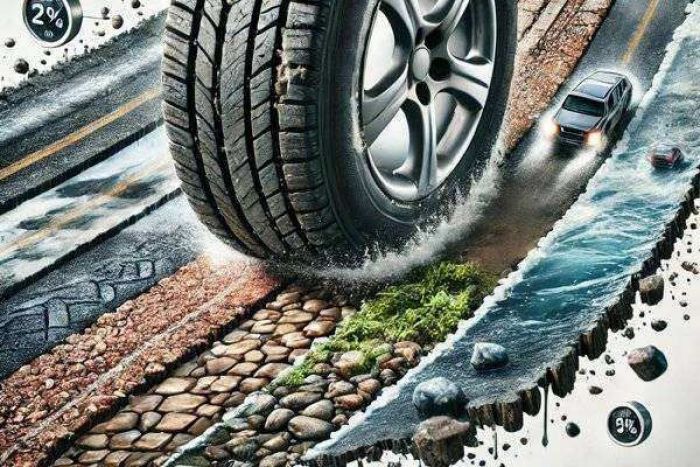



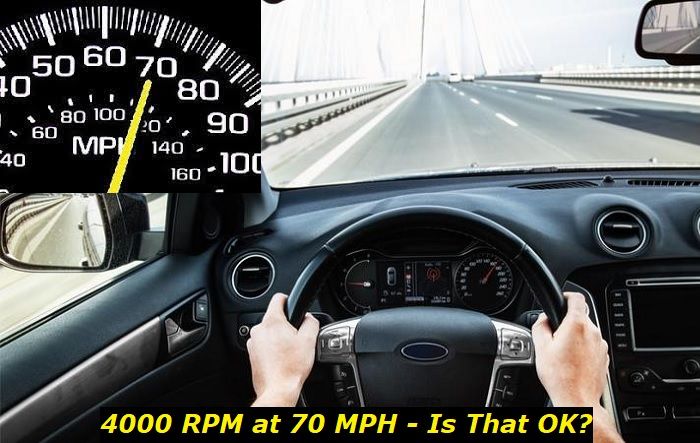
Add comment